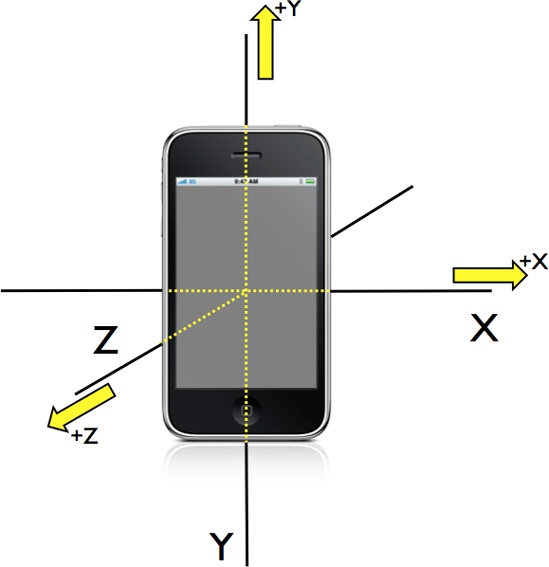An accelerometer measures the linear acceleration of the device. The original iPhone, and first generation iPod touch, use the LIS302DL 3-axis MEMS based accelerometer produced by STMicroelectronics. Later iPhone and iPod touch models use a similar LIS331DL chip, also manufactured by STMicroelectronics.
Both of these accelerometers can operate in two modes, allowing the chip to measure either ±2g and ±8g. In both modes the chip can sample at either 100 Mhz or 400 Mhz. Apple operates the accelerometer in the ±2g mode (presumably at 100 Mhz) with a nominal resolution of 0.018g. In the ±8g mode the resolution would be four times coarser, and the presumption must be that Apple decided better resolution would be more useful than a wider range. Under normal conditions the device will actually measure g-forces to approximately ±2.3g however measurements above a 2g are uncalibrated.
Note
While it should in theory be possible to change the operating mode of the accelerometer, there is currently no published API that allows you to do so within the SDK.
The iPhone’s accelerometer measures the linear acceleration of the device so it can report the device’s roll and pitch, but not its yaw. If you are dealing with a device that has a digital compass you can combine the accelerometer and magnetometer readings to have roll, pitch, and yaw measurements (see Chapter 5 for details on how to access the magnetometer).
Note
Yaw, pitch, and roll refer to the rotation of the device in three axes. If you think about an aircraft in the sky, pushing the nose down or pulling it up modifies the pitch angle of the aircraft. However, if you keep the nose straight ahead you can also modify the roll of the aircraft using the flaps; one wing will come up, the other will go down. By keeping the wings level you can use the tail flap to change the heading (or yaw) of the aircraft, rotating it in a 2D plane.
The accelerometer reports three figures: X, Y, and Z (see Figure 4-1). Acceleration values for each axis are reported directly by the hardware as G-force values. Therefore, a value of 1.0 represents a load of approximately 1-gravity (Earth’s gravity). X corresponds to roll, Y to pitch, and Z to whether the device is front side up or front side down, with a value of 0.0 being reported when the iPhone is edge-on.
When dealing with acceleration measurements you must keep in mind that the accelerometer is measuring just that: the linear acceleration of the device. When at rest (in whatever orientation) the figures represent the force of gravity acting on the device, and correspond to the roll and pitch of the device (in the X and Y directions at least). But while in motion, the figures represent the acceleration due to gravity, plus the acceleration of the device itself relative to its rest frame.
Get Basic Sensors in iOS now with the O’Reilly learning platform.
O’Reilly members experience books, live events, courses curated by job role, and more from O’Reilly and nearly 200 top publishers.


